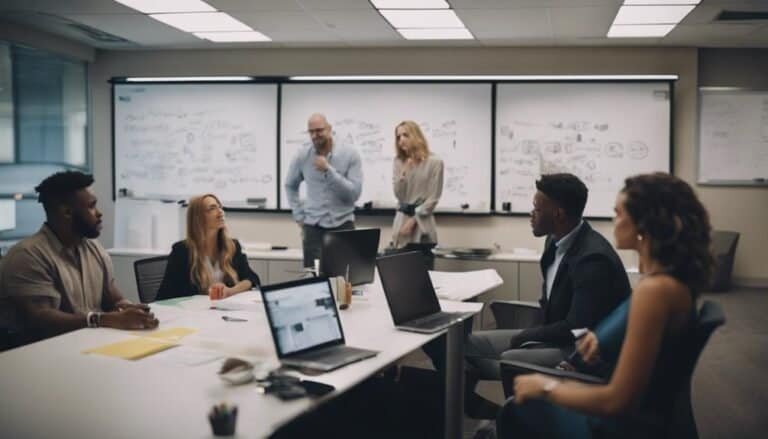Effective Communication Skills for Success in the Workplace
Imagine a ship navigating through rough waters; clear communication between the captain and the crew is essential to reach the desired destination safely.
In the workplace, effective communication serves as the compass guiding you towards success. From verbal strategies to nonverbal cues and active listening, mastering these skills can propel you forward in your career.
But what happens when communication falters, leading to misunderstandings or conflicts? Stay tuned to discover how honing your communication skills can not only avert such crises but also foster collaboration and growth in the workplace.
Key Takeaways
- Clear communication fosters workplace success and productivity.
- Active listening and conflict resolution are vital for effective communication.
- Building rapport through trust and integrity enhances professional relationships.
- Team collaboration thrives with open communication, feedback, and goal alignment.
Importance of Effective Workplace Communication
Effective workplace communication is essential for fostering collaboration and productivity among team members. Communication effectiveness is crucial for achieving workplace success. Clear and open communication within a team can lead to better problem-solving, increased efficiency, and a more positive work environment. When team members communicate effectively, they can share ideas, provide feedback, and address any issues that may arise promptly.
Furthermore, effective workplace communication helps in building strong relationships among team members, which can boost morale and overall job satisfaction. When everyone is on the same page and understands their roles and responsibilities clearly, it reduces misunderstandings and conflicts. This, in turn, paves the way for a more harmonious and productive work environment.
In essence, honing your communication skills and ensuring communication effectiveness in the workplace is key to achieving workplace success. By fostering a culture of open and transparent communication, you can enhance collaboration, productivity, and overall job satisfaction among team members.
Verbal Communication Strategies
When communicating at work, it's crucial to focus on clear speech delivery, active listening techniques, and understanding non-verbal cues.
Make eye contact, nod, and ask questions to show you're engaged in the conversation.
Clear Speech Delivery
To ensure your message is understood clearly in the workplace, focus on articulating your words with precision and confidence during verbal communication.
When it comes to clear speech delivery, consider the following:
- Practice Pronunciation: Work on enunciating each word clearly.
- Control Your Pace: Speak at a moderate speed to enhance clarity.
- Use Pauses Effectively: Pause between key points to allow for absorption.
- Project Your Voice: Ensure your voice carries well to all listeners.
Active Listening Techniques
To enhance your communication skills further, focus on mastering active listening techniques during verbal interactions in the workplace. Improving your listening skills is crucial for effective communication. Here are some communication techniques to help you become a better active listener:
| Active Listening Techniques | Description | Benefits |
|---|---|---|
| Maintain eye contact | Show interest and attentiveness | Enhances understanding |
| Ask clarifying questions | Ensure comprehension | Avoid misunderstandings |
| Paraphrase responses | Confirm understanding | Demonstrate engagement |
| Avoid interrupting | Respect the speaker | Foster trust and rapport |
| Provide feedback | Acknowledge the message | Encourage open communication |
Non-Verbal Cues Importance
Understanding the importance of non-verbal cues in verbal communication strategies is essential for effective workplace interactions. Non-verbal cues such as body language and facial expressions play a significant role in conveying messages and emotions.
Here are key reasons why non-verbal cues are crucial:
- Body language can convey confidence or nervousness without saying a word.
- Facial expressions provide insights into emotions and reactions.
- Non-verbal cues help to gauge the sincerity and credibility of a speaker.
- They contribute to building rapport and establishing trust in professional relationships.
Written Communication Best Practices
Effective workplace communication relies on implementing clear and concise written communication best practices.
When it comes to email etiquette, it's crucial to be mindful of your tone, grammar, and formatting. Always address the recipient appropriately, use professional language, and proofread your message before hitting send.
Writing skills are also essential for effective written communication. Make sure your message is well-structured, organized, and free of spelling or grammatical errors. Keep your sentences and paragraphs short to enhance readability and comprehension. Utilize bullet points or numbered lists for conveying information more effectively.
Remember to tailor your writing style to the specific audience you're addressing. By honing your email etiquette and writing skills, you can ensure that your written communication is clear, professional, and impactful.
Practice incorporating these best practices into your daily interactions to enhance your communication effectiveness in the workplace.
Nonverbal Cues and Body Language
When communicating in the workplace, pay close attention to nonverbal cues and body language as they play a crucial role in conveying messages effectively. Nonverbal cues and body language impact how your message is received, sometimes even more than your words. Here's why:
- Body Language Impact: Your body language can speak volumes without you uttering a single word, influencing how others perceive you.
- Subconscious Cues: Often, nonverbal communication sends hidden messages that reveal your true feelings or intentions.
- Nonverbal Communication: Understanding nonverbal cues can help you decode unspoken thoughts and emotions in others, improving overall communication.
- Hidden Messages: Being aware of subtle gestures or expressions can help you pick up on underlying meanings in conversations, leading to better understanding.
Active Listening Techniques
You can enhance your communication skills by practicing engaged listening and employing reflective questioning techniques. These active listening techniques will help you better understand others' perspectives and foster meaningful interactions in the workplace.
Engaged Listening Skills
To truly engage in effective communication at the workplace, hone your engaged listening skills through active listening techniques. When practicing engaged listening skills, remember to:
- Practice mindful listening to show respect and understanding.
- Use empathetic responses to connect on an emotional level.
- Maintain eye contact and open body language to show attentiveness.
- Summarize or paraphrase what you've heard to confirm understanding.
These active listening techniques not only enhance your communication skills but also foster a positive work environment. By being fully present in conversations and demonstrating empathy, you can build stronger relationships with your colleagues, improve teamwork, and boost overall productivity in the workplace.
Reflective Questioning Techniques
Implementing reflective questioning techniques enhances communication by encouraging deeper understanding and meaningful dialogue in the workplace. By incorporating critical thinking into your questioning strategies, you can prompt others to reflect on their responses, leading to more insightful discussions.
Reflective listening, where you paraphrase and summarize what others have said before asking questions, demonstrates active engagement and fosters a collaborative environment. When you engage in reflective questioning, you show a genuine interest in understanding others' perspectives, which can lead to building stronger relationships and resolving conflicts more effectively.
Conflict Resolution Through Communication
Mastering conflict resolution through effective communication is essential for fostering a harmonious and productive work environment. When conflicts arise, it's crucial to address them promptly and efficiently.
Here are some key strategies to help you navigate through conflict resolution using communication:
- Active Listening: Listen attentively to understand all perspectives involved.
- Remaining Calm: Keep your emotions in check to approach the situation rationally.
- Seeking Compromise: Look for solutions that benefit all parties involved.
- Clarifying Expectations: Clearly communicate expectations to avoid future misunderstandings.
Building Rapport and Relationships
Building strong rapport and relationships in the workplace is crucial for fostering a positive and collaborative environment. Trust building is a foundational element in establishing meaningful connections with your colleagues. It involves being honest, reliable, and consistent in your interactions. By demonstrating integrity and keeping your promises, you can earn the trust of others and create a supportive work atmosphere.
Networking skills play a vital role in expanding your professional circle and enhancing your career opportunities. Actively engaging with coworkers, attending industry events, and participating in team-building activities can help you build a strong network of contacts. Remember to listen attentively, show genuine interest in others, and offer assistance whenever possible. These actions can help you forge lasting relationships that may benefit your career in the long run.
Conclusion
In conclusion, remember that 'actions speak louder than words.' By honing your communication skills, you can achieve success in the workplace. Practice active listening, utilize effective verbal and written communication strategies, and pay attention to nonverbal cues.
Conflict resolution and building relationships are key components of effective communication. Keep in mind that communication is a two-way street, and by mastering these skills, you can navigate the workplace with confidence and professionalism.







